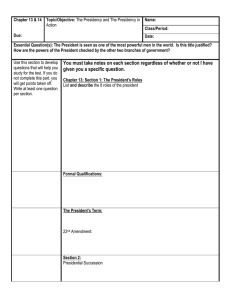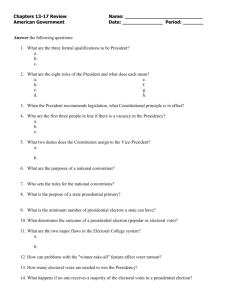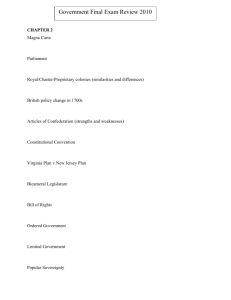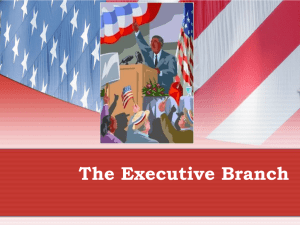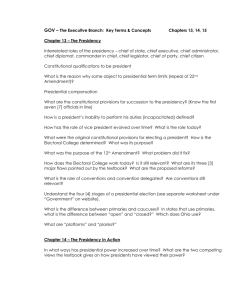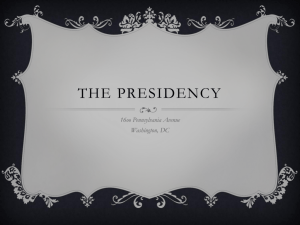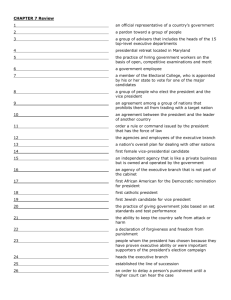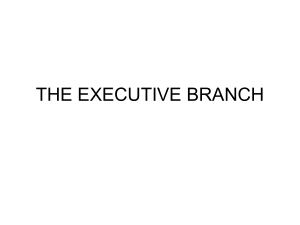Executive Branch
advertisement
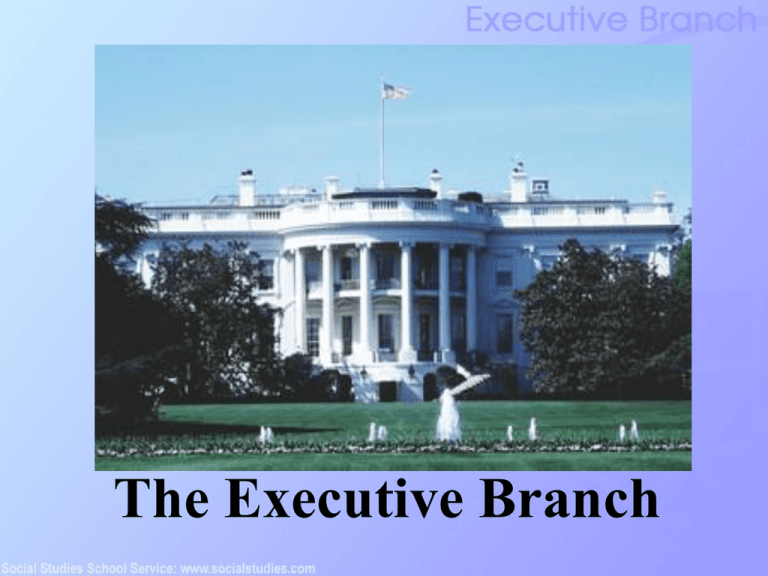
The Executive Branch Warm-up Activity • View the next few slides. • On the left side of the slide will be pictures of presidents at the beginning of their term. • The pictures on the right are later on in their terms. • What do you notice about each set of pictures? President Clinton President Bush President Reagan President Carter Drawing Conclusions Based on the pictures you viewed, what conclusions can you make about the job of the president? (Record in your notes) Presidential Trivia!!! • Who was the youngest President to be elected to office? Answer: John F. Kennedy age 43 • Who was the youngest President to serve in office? Answer: Theodore Roosevelt age 42 • Who was the oldest president to take office? Answer: Ronald Reagan age 69 Executive Branch: Inception • • • • The Articles of Confederation: combined executive and legislative branches The Virginia Plan: proposed separate executive and legislative branches Some feared a strong executive branch could lead to tyranny or monarchy Checks on executive power Pennsylvania delegate James Wilson The President’s Term • The Founding Fathers agreed that a president should serve a 4 year term. • Do you think this is too long or too short? • Write a list describing the pros and cons of a 4 year term The President’s Term • One Founding Father, Alexander Hamilton said: “that four years was long enough period for a President to have gained experience, demonstrated his abilities, and established stable policies” Terms Continued… • Until 1951, there was no limit on the number of terms a President might serve. • What president was elected to 4 terms in office? • Answer: Franklin D. Roosevelt • In 1951 the 22nd Amendment was adopted • Presidential terms were limited to two full terms- eight years-in office The President’s Job Description • “Unlike Britain and other democratic monarchies, we ask our country’s leader to do two jobs simultaneously, to act both as head of government and as the symbol of the nation. It’s a hard act. Governing involves tough compromises and gritty reality. We demand a street-smart wheeler dealer, but we also want a king and a royal family.” – Robert Reich Secretary of Labor under Clinton Presidential Requirements and Roles • • • John F. Kennedy became the youngest president to take office To be eligible to become president, you must: Be at least 35 years old Have been born in the U.S. Have resided in the U.S. for at least 14 years Presidential Term of Office • • The two-term precedent The 22nd Amendment George Washington set the two-term precedent President Franklin D. Roosevelt was elected to four terms The 25th Amendment • • • Deals with instances in which the president dies or becomes disabled Established an order of succession Set rules for choosing a new vice-president Lyndon Johnson takes the presidential oath of office after the assassination of JFK Presidential Powers • • • • • Executive Legislative Judicial Diplomatic Military Executive Powers • • • • Chief Executive Executive orders Appointments Removals President Richard Nixon signs an Executive Order Legislative Powers (Chief Legislator) • • • • President George H.W. Bush signs into law the 1990 Americans with Disabilities Act Recommend legislation to Congress Approve measures passed by Congress Veto power Call special sessions of Congress Judicial Powers • • • • • Appointment of federal judges Reprieves Pardons Commutations Amnesty Supreme Court Justice Warren Burger and President Nixon at press conference announcing Burger as new Chief Justice Military Powers (Commander-in-Chief) • • • President Lyndon Johnson pins a medal on soldier in Vietnam Commander in chief of the U.S. military Power to deploy troops The War Powers Resolution Diplomatic Powers (Chief Diplomat) • Treaties • Recognition • Setting foreign policy President Kennedy signs the 1963 Nuclear Test Ban Treaty The Cabinet • • • Advises the president Not mentioned in the Constitution George Washington’s Cabinet The Modern Cabinet The Growth of Presidential Power • Only government official elected by the country as a whole • Executive branch: decisions made by one person • Congressional legislation • Executive Orders The Electoral College • • • Reasons for the creation of the Electoral College Choosing electors Ballots cast in December, made official in January The Electoral College meets in 1876 Electoral Votes • • • California has the most electoral votes; states like Wyoming and Vermont have the least Calculating electoral votes Of 538 electoral votes: 435 = House of Representatives 100 = The Senate The 23rd amendment Electoral College Reform • • • “Winner-take-all” system Problems Proposed reforms o Direct Popular Election o Percentage/ Proportional o District Presidential Primaries and Caucuses • • Future president Gerald Ford runs for Congress in the 1948 Michigan primary Primary: an election held to pick a party’s candidates for a general election Caucus: a group of people (usually those from a single political party) who meet to choose a candidate to support in a general election National Conventions • • • Delegates formally select candidates for president and vice-president Platform: a party’s formal statement about its positions, goals, and principles Unity Ronald Reagan gives his acceptance speech at the 1984 Republican national convention Presidential Elections • • • Held every four years First Tuesday in November Inauguration dates The Vice-President Andrew Johnson John Tyler Theodore Roosevelt

